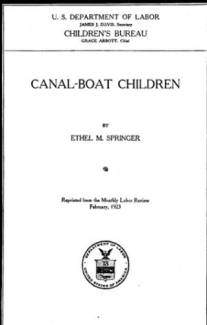Collection Name
About
Canal-boat Children.
By Ethel M. Springer
REPORTS of unfavorable conditions among children living on canal boats in England, and rumors that unfavorable conditions also existed among children living on waterways in the United States, led the Federal Children's Bureau to make an inquiry into the situation in this country. Through preliminary correspondence it was learned that probably the only canals upon which any number of families lived upon barges were the Chesapeake and Ohio Canal in Maryland, the Lehigh and the Delaware Division Canals in Pennsylvania, and the canal system in New York State.
A field inquiry was therefore made by the bureau during the year 1921 along the canals in Maryland and New York State, a similar study of the situation on the Pennsylvania canals being undertaken simultaneously by the Pennsylvania Public Education and Child Labor Association. The findings of these inquiries indicate that while the number of children living on canal boats in this country is small, the conditions under which they are living and working present unusually serious problems. School attendance is difficult, hours of work are excessively long, doctors are inaccessible, and proper recreation is lacking.
Canal operation in the United States began early in the nineteenth century and reached the height of its activity about 1870. With the extended development of railroads, however, came a decline in the importance of canal transportation. In 1908, when the last comprehensive report on the subject was issued by the Government, 45 canals were listed as in operation and 54 as abandoned. Despite this fact, considerable attention has been given during in the last decade to the development of inland waterways. In 1918 New York State opened the new State Barge Canal, having greater depth and width than the old Erie Canal which it supersedes, and modern locks capable of use by large steam-towed vessels. Gradually the canals which were constructed with so little width and depth that only small mule-drawn boats could use them have been abandoned, until now the only important canals on which mules are used are the Chesapeake and Ohio Canal and the Lehigh Canals.
Used with permission of the Maternal and Child Health Group, Georgetown University.
